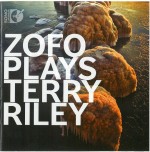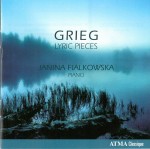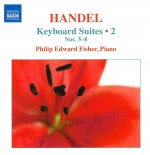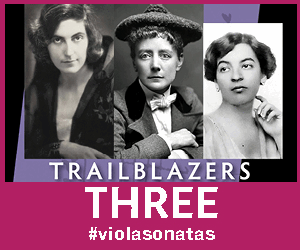Duo pianists are fascinating couplings and each is wonderfully unique. The dynamic choreography of duo pianism allows each partner to lead, follow or be subsumed in the music they play. It’s a breathtaking and elegant dance when done well.
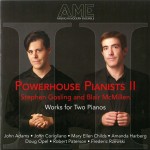 Powerhouse Pianists II (American Modern Recordings AMR 1039) presents Stephen Gosling and Blair MacMillen in a program of American works highlighted by John Adams’ Hallelujah Junction and John Corigliano’s Chiaroscuro. Gosling/MacMillen play the Adams with a revivalist fervour evocative of traditional camp meetings. Chiaroscuro requires one of the two pianos to be tuned down a quartertone producing an arresting effect that Corigliano exploits in many ways. This is especially effective in the final movement titled Strobe.
Powerhouse Pianists II (American Modern Recordings AMR 1039) presents Stephen Gosling and Blair MacMillen in a program of American works highlighted by John Adams’ Hallelujah Junction and John Corigliano’s Chiaroscuro. Gosling/MacMillen play the Adams with a revivalist fervour evocative of traditional camp meetings. Chiaroscuro requires one of the two pianos to be tuned down a quartertone producing an arresting effect that Corigliano exploits in many ways. This is especially effective in the final movement titled Strobe.
The other real delight on this disc is Frederic Rzewski’s Winnsboro Cotton Mill Blues. Somewhat programmatic, it captures the pounding industrial din of a mill while introducing elements of an old work song that laments the burden of daily toil in such a setting. The latter half offers a seductive blues section that both pianists glide through with an easy swing before they let the composer conclude with the familiar rhythm of the mill.
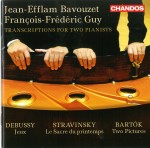 Another piano duo with a recent recording on the shelves is Jean-Efflam Bavouzet and François-Frédéric Guy. Their performance of Transcriptions for Two Pianists (CHANDOS CHAN 10863) opens with Bartók’s Two Pictures transcribed by pianist/conductor Zoltán Kocsis. Kocsis knows that the voices excluded are as important as those that find their way to the keyboard. He understands the different economies of both palettes and so do the pianists. This makes for a terrific transcription. Two Pictures is a set of great contrast with In Full Flower strongly evoking the influence that Debussy had on Bartók. Village Dance delivers the powerful impulse of rustic folk rhythms that Bartók used often in other works.
Another piano duo with a recent recording on the shelves is Jean-Efflam Bavouzet and François-Frédéric Guy. Their performance of Transcriptions for Two Pianists (CHANDOS CHAN 10863) opens with Bartók’s Two Pictures transcribed by pianist/conductor Zoltán Kocsis. Kocsis knows that the voices excluded are as important as those that find their way to the keyboard. He understands the different economies of both palettes and so do the pianists. This makes for a terrific transcription. Two Pictures is a set of great contrast with In Full Flower strongly evoking the influence that Debussy had on Bartók. Village Dance delivers the powerful impulse of rustic folk rhythms that Bartók used often in other works.
Debussy’s Jeux follows in a transcription by Bavouzet. His liner note argues for the benefit of hearing Jeux presented by the relatively “neutral” colours of the piano. It’s a curious statement, especially since each of the ten movements is clear and sparkles and is anything but neutral.
Bavouzet and Guy face their biggest challenge with Stravinsky’s two piano score of The Rite of Spring. Completed and published a year before the orchestral version and subsequent ballet performance, this work demands everything a pianist can bring to the keyboard from the ethereally subtle to the brutally savage. It’s an explosive piece and a brilliant performance.
Review
Composer Terry Riley has for years been an ambassador for Western musicians who find a strong attraction to a creative mélange of minimalism, eastern traditions, polyrhythms and generally “out there” edgy adventurism. His all-night improvisations in the mid-60s in Philadelphia are legendary. His many collaborations with the likes of Chet Baker, The Who, Philip Glass and the Kronos Quartet are equally so. It’s no surprise then, to find the piano duo (four hands) ZOFO recording an entire CD of his works. Eva Maria-Zimmermann and Keisuke Nakagoshi began their duo collaboration in 2009 and since then have issued four CDs. This latest, ZOFO plays Terry Riley (Sono Luminus DSL 92189) reflects their appetite for the unconventional. To be sure, their few discs do cover some standard repertoire but there is a strong drive in this pair of San Francisco-based performers to find and play the most challenging music they can handle. The result is never short of pure excitement.
Jaztine, the opening track, suggests what might have happened had Gershwin reinterpreted Ravel’s deconstructionist La Valse. Simone’s Lullaby is remarkable for its hypnotic bell-like piano playing. G Song has the feel of a Bach fugue making new friends at a jazz/blues jam session, and Praying Mantis Rag is brilliantly light-hearted fun from start to finish.
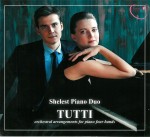 A new piano duo on the scene is the Ukrainian-born, and now New York-based couple, Anna and Dmitri Shelest. Shelest Piano Duo have released their first recording TUTTI (Sorel Classics SC CD 002) with five substantial standard repertoire items. Among the disc’s highlights are Liszt’s own arrangement of his Les Préludes played with consistent brilliance and sensitivity through to its magnificent conclusion. Tchaikovsky’s Sixth Symphony Allegro is an impressive display of melody and countermelody beautifully balanced and phrased. Ravel’s La Valse for four hands is rarely heard since the composer only arranged it for two pianos as well as solo piano. At his request, his friend Lucien Garban set it for piano four hands. The Shelests capture the chaos and complexity familiar in the orchestral version and bring it to a stunning finish. They conclude their CD with Henry Levine’s arrangement of Gershwin’s Rhapsody in Blue. This too, is usually heard as a solo or a two-piano performance and hearing this version is a novel treat.
A new piano duo on the scene is the Ukrainian-born, and now New York-based couple, Anna and Dmitri Shelest. Shelest Piano Duo have released their first recording TUTTI (Sorel Classics SC CD 002) with five substantial standard repertoire items. Among the disc’s highlights are Liszt’s own arrangement of his Les Préludes played with consistent brilliance and sensitivity through to its magnificent conclusion. Tchaikovsky’s Sixth Symphony Allegro is an impressive display of melody and countermelody beautifully balanced and phrased. Ravel’s La Valse for four hands is rarely heard since the composer only arranged it for two pianos as well as solo piano. At his request, his friend Lucien Garban set it for piano four hands. The Shelests capture the chaos and complexity familiar in the orchestral version and bring it to a stunning finish. They conclude their CD with Henry Levine’s arrangement of Gershwin’s Rhapsody in Blue. This too, is usually heard as a solo or a two-piano performance and hearing this version is a novel treat.
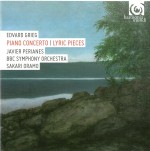 Recent months have seen three pianists issue recordings of Grieg’s Lyric Pieces. Spanish pianist Javier Perianes (Edvard Grieg – Piano Concerto/Lyric Pieces, BBC Symphony Orchestra, Sakari Oramo, harmonia mundi HMC 902205) adds the Grieg piano concerto to his program making the disc a very attractive buy. The signature opening theme tells us immediately that we are listening to a performer with strong convictions at the keyboard. In his mid-20s, Perianes (about the same age as Grieg when he wrote the concerto) takes a very slightly slower tempo with the piece than we normally hear. His collaboration with Finnish conductor Sakari Oramo produces a very balanced performance that never feels rushed despite the many passages of mounting energy.
Recent months have seen three pianists issue recordings of Grieg’s Lyric Pieces. Spanish pianist Javier Perianes (Edvard Grieg – Piano Concerto/Lyric Pieces, BBC Symphony Orchestra, Sakari Oramo, harmonia mundi HMC 902205) adds the Grieg piano concerto to his program making the disc a very attractive buy. The signature opening theme tells us immediately that we are listening to a performer with strong convictions at the keyboard. In his mid-20s, Perianes (about the same age as Grieg when he wrote the concerto) takes a very slightly slower tempo with the piece than we normally hear. His collaboration with Finnish conductor Sakari Oramo produces a very balanced performance that never feels rushed despite the many passages of mounting energy.
After the powerful finish to the first movement, Perianes performs the following Adagio with a remarkable tenderness and tentative voice. The overall effect is one of fragility that leaves the beauty of the main theme lingering in the memory. In the final movement he recalls the thematic material with familiar phrasing and marches confidently toward the frenetic build-up that closes the concerto with its thunderous chords.
The disc then moves into a selection of just 12 of Grieg’s 66 Lyric Pieces. Written throughout his composing career, these span nearly four decades of his life. Perianes makes careful choices insofar as he wants to demonstrate the wide variations of character and mood these little pieces represent. And in contrast to the concerto, Perianes now plays from an entirely different place, one of intimacy, introspection and fantasy. His approach to the Lyric Pieces is steady and mature. He avoids overindulgence in any expressive technique. Still there is plenty of tastefully applied rubato and dynamic freedom to support the emotional program that Grieg indicates in his titles.
March of the Trolls is played at a noticeably faster speed than most often heard but this seems to emphasize the sinister nature of the imagery. The mid-section, by contrast, is played with exquisite touch and Perianes manages to somehow leave it suspended in the air. His performance of Nocturne is wonderfully Debussy-like, but his finest two pieces are Homesickness and At Your Feet. With careful dynamics and beautifully placed hesitations he conveys a palpable sense of longing to the listener. Perianes is a sensible young artist who avoids the temptingly flashy in favour of fidelity to a composer’s intent.
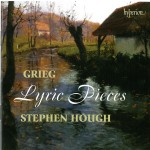 British pianist Stephen Hough has also released a selection of Grieg – Lyric Pieces (Hyperion CDA68070), though considerably larger, numbering 27. Hough is twice the age of Perianes and so one immediately expects an interpretive approach that reflects both that experience and maturity. While these traits are certainly evident, what really emerges is the fact that Hough lives in a world of much wider dynamic energy where rubato and phrase end pull-backs are powerful devices that he uses most effectively. Erotikon demonstrates this best and shows that Hough’s boundaries for expressive devices are set at very generous distances. To Spring seems to disappear into an emotional void as he finishes the piece. Butterfly shows his remarkable and articulate dexterity. He plays Bell Ringing with a touch that never fully engages the percussive nature of the piano hammer, and thereby makes the strings speak with no audible beginning. His Little Bird characterization is brilliant for all its nervous energy. And his March of the Trolls is wild and threatening before it melts into the beauty of the mid-section theme. Here, as in many other instances, Hough is able to pull the main musical idea further forward, out of the surrounding harmonies, than most pianists care to do. It’s consistent with his assertive interpretive style and works very well.
British pianist Stephen Hough has also released a selection of Grieg – Lyric Pieces (Hyperion CDA68070), though considerably larger, numbering 27. Hough is twice the age of Perianes and so one immediately expects an interpretive approach that reflects both that experience and maturity. While these traits are certainly evident, what really emerges is the fact that Hough lives in a world of much wider dynamic energy where rubato and phrase end pull-backs are powerful devices that he uses most effectively. Erotikon demonstrates this best and shows that Hough’s boundaries for expressive devices are set at very generous distances. To Spring seems to disappear into an emotional void as he finishes the piece. Butterfly shows his remarkable and articulate dexterity. He plays Bell Ringing with a touch that never fully engages the percussive nature of the piano hammer, and thereby makes the strings speak with no audible beginning. His Little Bird characterization is brilliant for all its nervous energy. And his March of the Trolls is wild and threatening before it melts into the beauty of the mid-section theme. Here, as in many other instances, Hough is able to pull the main musical idea further forward, out of the surrounding harmonies, than most pianists care to do. It’s consistent with his assertive interpretive style and works very well.
Review
Janina Fialkowska takes a very different approach in Grieg – Lyric Pieces (ATMA Classique ACD2 2696). One searches in vain for some Eastern philosophical term to describe her artistic posture. The effect is, however, one of perfect calm, where no statement is rushed and there is no need to say anything until the music is ready. Her expression at the keyboard hints at understatement and reservation yet never lacks in rubato or dynamic expression. She plays with a subtle containment that is entirely satisfying even if we never hear the piano rattle mechanically under a maniacal fortissimo. Her opening track Arietta reflects this standard as does Sylph, and she never wavers from it.
Norwegian Dance sustains an entrancing left-hand drone while her right hand, with complete independence, plays out the folk tune. Brooklet is an example of brilliant, articulate playing which she carries even further in Puck for a memorable impish, elfish effect. She underscores Grieg’s German musical education in At Your Feet, reminding us of how Brahmsian this piece can sound. Finally, her March of the Trolls is completely unlike either the Hough or Perianes performance. Fialkowska takes the piece at a slower, more march-like pace. She also leaves plenty of breathing space around the beautiful central theme of the slow section. Fialkowska’s Lyric Pieces are very different and uniquely hers.
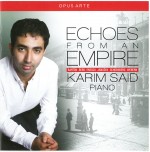 Karim Said – Echoes From An Empire (Opus Arte OA CD9029D) has programmed his first recording with a remarkable purpose in mind: to survey the music that was written during the protracted demise of the Austro-Hungarian Empire and explore its message about the passage of the old and the advent of the new. To that end he performs works spanning the years 1903 to 1927 from Berg, Webern, Janáček, Enescu, Bartók and Schoenberg. Now 27, he shows a remarkable understanding of the music of this period and what its composers were doing in this era of profound transition.
Karim Said – Echoes From An Empire (Opus Arte OA CD9029D) has programmed his first recording with a remarkable purpose in mind: to survey the music that was written during the protracted demise of the Austro-Hungarian Empire and explore its message about the passage of the old and the advent of the new. To that end he performs works spanning the years 1903 to 1927 from Berg, Webern, Janáček, Enescu, Bartók and Schoenberg. Now 27, he shows a remarkable understanding of the music of this period and what its composers were doing in this era of profound transition.
He plays as if he were a seer of some kind. The sonatas by Berg and Janáček are fine examples of this, especially the second movement of the Janáček, titled Death. The transcendence of this is powerful and reaches far beyond the mere notes and the composer’s other markings. Similarly, his performance of Bartók’s Three Rondos on Slovak Folk Tunes seems so perfect a cultural iteration that Said’s birthplace, Amman, Jordan, seems a universe distant.
Enescu’s Suite No.2 in D Op.10 is a remarkably beautiful composition in its richness of form and melody. Said plays the opening Toccata with all the majesty its tempo marking designates. The following Sarabande is performed with such a delicate touch that the sounds of the instrument seem pure velvet. The closing Boureé is an energized finale that sparkles with virtuosity. We need to hear more from this young pianist. His touring schedule leaves him little time for recording. But record more he certainly must.
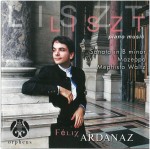 The decision to record the Liszt B Minor Sonata may say more about a performer than the actual performance. Hearing the final product, however, seals the judgment. On Liszt piano music (Orpheus OR 3906-1828) young (mid-20s) Spanish superstar Félix Ardanaz presents this Everest of the piano repertoire in a way that allows one to forget about its technical demands and focus instead on both the emotional and intellectual brilliance Liszt wrote into it. With three of its six themes presented in the first 18 measures alone, Ardanaz identifies and presents the ideas with the clarity needed to help the listener follow Liszt’s plan through the ensuing half hour of playing.
The decision to record the Liszt B Minor Sonata may say more about a performer than the actual performance. Hearing the final product, however, seals the judgment. On Liszt piano music (Orpheus OR 3906-1828) young (mid-20s) Spanish superstar Félix Ardanaz presents this Everest of the piano repertoire in a way that allows one to forget about its technical demands and focus instead on both the emotional and intellectual brilliance Liszt wrote into it. With three of its six themes presented in the first 18 measures alone, Ardanaz identifies and presents the ideas with the clarity needed to help the listener follow Liszt’s plan through the ensuing half hour of playing.
So much of this performance is astonishing, but little more so than Liszt’s treatment of one of his opening ideas as a fugal subject midway through the work, followed by a seemingly impossible piu mosso direction. Ardanaz delivers this effortlessly. No subtlety escapes him, whether a brief tender Adagio or an explosive passage whose power falls under his complete control.
Ardanaz also includes both Mazeppa and Mephisto Waltz in his program. Astonishing throughout, this is definitely a “must-have” disc.
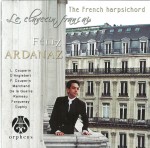 Before the awe over Félix Aradanaz begins to settle, it’s worth briefly mentioning his recording of French harpsichord repertoire on The French Harpsichord (Orpheus OR3906-1811). The transition between instruments is clearly the issue here and not much rationale is offered either in print or online as to why he does this. Very few pianists undertake such a bold recording choice but nothing seems beyond his reach. Ardanaz clearly understands the ornamentation styles and forms of early music, free as much of it is from the more firmly metered romantic repertoire he plays so well. Still he appears to have mastered the challenges of fingering, articulation and phrasing, especially of legato lines. Chaconne in D Minor by L. Marchand is an excellent example of nimble speed coupled with grand sustained chords so difficult to achieve on this instrument. Ardanaz includes works by Rameau, both Couperins, D’Anglebert and others on this disc. A very fine recording for early music followers.
Before the awe over Félix Aradanaz begins to settle, it’s worth briefly mentioning his recording of French harpsichord repertoire on The French Harpsichord (Orpheus OR3906-1811). The transition between instruments is clearly the issue here and not much rationale is offered either in print or online as to why he does this. Very few pianists undertake such a bold recording choice but nothing seems beyond his reach. Ardanaz clearly understands the ornamentation styles and forms of early music, free as much of it is from the more firmly metered romantic repertoire he plays so well. Still he appears to have mastered the challenges of fingering, articulation and phrasing, especially of legato lines. Chaconne in D Minor by L. Marchand is an excellent example of nimble speed coupled with grand sustained chords so difficult to achieve on this instrument. Ardanaz includes works by Rameau, both Couperins, D’Anglebert and others on this disc. A very fine recording for early music followers.
Review
British pianist Philip Edward Fisher has now followed his first recording of Handel’s keyboard music with a second instalment, Handel Keyboard Suites 2 (NAXOS 8.573397). Fisher brings a balanced sensibility to this performance, having decided clearly where he will draw the line at expressive keyboard techniques. Having been written for the harpsichord, no dynamics would have been contemplated by the composer, but Fisher introduces them with subtlety and respect. The result is very satisfying. His freedom with tempi and crisp ornamental figures adds even more to the richness of the music. Handel might have been very pleased to hear this approach. Suite No.7 in G Minor contains an especially lovely and mellow Andante as well as a couple of fast movements delightful for their articulation. The fugue in the second movement of Suite No.8 is far more full-sounding on the piano than it ever could be on the harpsichord. Fisher’s performance is refreshing and his future releases worth following.


